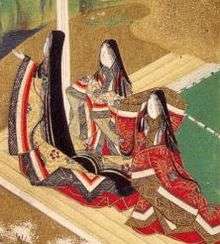Tomesode

Tomesode (留袖) is a type of kimono. It is an expensive formal dress worn by married women.
Originally, there was a custom that the long sleeves of the furisode were shortened after marriage, thereby creating a tomesode. This was because the long swinging sleeves would be impractical when the married woman worked in the kitchen. The word "tomesode" itself consists of two kanji meaning "to fasten" (留) and "sleeve" (袖).
The tomesode distinguishes itself from other kimono by only having patterns under the waistline. It has five or sometimes three family crests, or kamon, which indicates the formality of the kimono.
Kuro-tomesode (black tomesode) are often worn for wedding ceremonies by married female relatives of the bride or groom. The eri, obijime and obiage are always white, and the obi matches the colourful pattern of the kimono to signify a happy occasion. It is believed that the black colour is to match the clean white colour of the bride, as this kimono is rarely used at other occasions than weddings of near family members (sisters or daughters). A friend of the bride or groom would not wear kurotomesode, but homongi or iro-tomesode.
At events at the imperial palace, it is strictly forbidden to wear kuro-tomesode, and here iro-tomesode is worn.
Iro-tomesode is the second most formal kimono and is similar to the kuro-tomesode, except that it has light colours instead of being black. It can be worn at weddings by married women not closely related to the bride or groom or at other festive occasions.
External links
- Tomesode GoJapanGo
- Antique kimono flea market
| ||||||||||||||||||||
